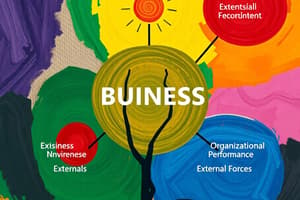Podcast
Questions and Answers
What has increased due to globalization that is vital for managers?
What has increased due to globalization that is vital for managers?
- Single-culture communication skills
- Cross-cultural communication skills (correct)
- Reduced competition
- Isolationist communication strategies
Which factor is NOT part of PESTLE analysis?
Which factor is NOT part of PESTLE analysis?
- Sociocultural
- Emotional (correct)
- Technological
- Environmental
How does social media presence impact businesses in 2024?
How does social media presence impact businesses in 2024?
- It is critical for brand visibility. (correct)
- It complicates communication strategies.
- It is entirely optional for growth.
- It decreases customer engagement.
What is a primary benefit of globalization for businesses?
What is a primary benefit of globalization for businesses?
What type of changes are included under Political factors in PESTLE analysis?
What type of changes are included under Political factors in PESTLE analysis?
Which of the following statements about outsourcing is true in the context of globalization?
Which of the following statements about outsourcing is true in the context of globalization?
What is a significant reason for businesses to engage in PESTLE analysis?
What is a significant reason for businesses to engage in PESTLE analysis?
Which item would fall under the Sociocultural factor in PESTLE analysis?
Which item would fall under the Sociocultural factor in PESTLE analysis?
What does Foreign Direct Investment (FDI) primarily involve?
What does Foreign Direct Investment (FDI) primarily involve?
Which of the following is a key characteristic of international franchising?
Which of the following is a key characteristic of international franchising?
How has the pandemic affected the e-commerce landscape?
How has the pandemic affected the e-commerce landscape?
What trend has been observed regarding remote work post-pandemic?
What trend has been observed regarding remote work post-pandemic?
Which of these options describes licensing intellectual property?
Which of these options describes licensing intellectual property?
What is a key aspect of international joint ventures?
What is a key aspect of international joint ventures?
What advantage do AI solutions provide for customer service operations?
What advantage do AI solutions provide for customer service operations?
Which statement best defines global trends?
Which statement best defines global trends?
What is the primary difference between external and internal environmental forces?
What is the primary difference between external and internal environmental forces?
Which of the following is an example of internal environmental forces?
Which of the following is an example of internal environmental forces?
What process involves gathering, analyzing, and sharing data about the organization's environment?
What process involves gathering, analyzing, and sharing data about the organization's environment?
How is a local business defined?
How is a local business defined?
What type of environmental forces includes factors like customers or investors?
What type of environmental forces includes factors like customers or investors?
What is the purpose of benchmarking in environmental scanning?
What is the purpose of benchmarking in environmental scanning?
Which of the following is NOT considered an economic external force?
Which of the following is NOT considered an economic external force?
What best describes a business engaged in activities across multiple countries?
What best describes a business engaged in activities across multiple countries?
Flashcards
Business Environment
Business Environment
The surroundings in which an organization operates, made up of both internal and external factors that can influence its success.
External Forces
External Forces
Forces outside of the organization that can either positively or negatively affect its performance.
Internal Forces
Internal Forces
Forces inside the organization that can either positively or negatively affect its performance.
General External Forces
General External Forces
Signup and view all the flashcards
Specific External Forces
Specific External Forces
Signup and view all the flashcards
Environmental Scanning
Environmental Scanning
Signup and view all the flashcards
Local Business
Local Business
Signup and view all the flashcards
International Business
International Business
Signup and view all the flashcards
Foreign Direct Investment (FDI)
Foreign Direct Investment (FDI)
Signup and view all the flashcards
International Franchising
International Franchising
Signup and view all the flashcards
Licensing Intellectual Property
Licensing Intellectual Property
Signup and view all the flashcards
International Joint Ventures
International Joint Ventures
Signup and view all the flashcards
Global Trend
Global Trend
Signup and view all the flashcards
Globalization
Globalization
Signup and view all the flashcards
PESTLE analysis
PESTLE analysis
Signup and view all the flashcards
Political factors
Political factors
Signup and view all the flashcards
Economic factors
Economic factors
Signup and view all the flashcards
Sociocultural factors
Sociocultural factors
Signup and view all the flashcards
Technological factors
Technological factors
Signup and view all the flashcards
Legal factors
Legal factors
Signup and view all the flashcards
Environmental factors
Environmental factors
Signup and view all the flashcards
Study Notes
The Firm and its Environment
- The business environment comprises external and internal forces
- External forces are outside the organization, impacting performance positively or negatively.
- Internal forces are within the organization, influencing performance.
Environmental Forces - External
-
General:
-
Economic factors (inflation, exchange rates, recessions, supply and demand)
-
Sociocultural factors (consumer demographics, culture, lifestyle)
-
Political and legal factors (government policy, legislative changes, tax laws, employment laws)
-
Technological factors (changes in technology, use in sectors, research)
-
Demographic factors (population trends, age distribution, etc.)
-
World and ecological situations
-
Specific:
-
Stakeholders (customers, pressure groups, investors, employees)
Environmental Forces - Internal
- Resources
- Research and Development
- Production
- Procurement of Supplies
- Products and Services
Environmental Scanning
- A process to gather, analyze, and distribute data on an organization's environment for strategic or tactical purposes.
Components of Environmental Scanning
- Considering future business scenarios
- Benchmarking (comparing products to industry leaders for improvement)
- Developing a competitive mindset
- Business prediction or forecasting
Local and International Business Environment of the Firm
-
Local Businesses:
-
Businesses conducting economic transactions within a single country's borders.
-
Examples include grocery stores, law firms, manufacturing companies, and banks operating regionally.
-
International Businesses:
-
Businesses operating beyond a single country, handling economic transactions globally.
-
Examples include foreign direct investment (FDI), international franchising, licensing intellectual property, and international joint ventures.
Differences Between Domestic and International Businesses
-
Domestic Business:
-
Limited market scope (one country)
-
Local customers
-
Typically smaller market size
-
Local laws and regulations govern operations
-
Familiar with local culture and customs
-
Fewer risks and trade barriers
-
Less competition (typically local businesses)
-
Lower operational costs
-
Simpler business environment
-
Less exposure to global economic risks
-
Easier access to local resources and suppliers
-
International Business:
-
Global market scope (multiple countries)
-
Diverse customer base
-
Larger market size
-
Multiple laws/regulations across countries
-
Adaptation to diverse cultures necessary
-
Higher risks and trade barriers
-
More competition (from global competitors)
-
Higher operational costs
-
More complex business environment
-
Exposure to global economic risks
-
Access to global resources and suppliers
Global Trends
-
General developments or changes impacting multiple countries.
-
Examples:
-
Artificial intelligence (AI): AI solutions boost customer service efficiency and reduce spending. Training generative AI simplifies advertising and marketing.
-
E-commerce: The pandemic accelerated e-commerce, altering consumer behaviour and creating new distribution models. Continued modest growth is apparent post-pandemic.
-
Remote/Hybrid Work: Employees value remote work for financial advantages, and companies are implementing remote work monitoring technology.
-
Social media: Increasing social media users represent business opportunity for growth. Social media presence is critical for present-day businesses.
Effects of Globalization to Management Principles
- Globalization: Interconnectedness of world economies and cultures.
- Effects on Management:
- Greater need for cross-cultural communication skills.
- Increased competition.
- Rise of outsourcing/offshoring practices to reduce costs.
- Need for effective, consistent communication.
- Increased access to new markets.
- Greater flexibility sourcing materials/labor.
- Learning from other cultures and adapting.
- More opportunities for innovation
PESTLE Analysis
-
A tool for analyzing external factors influencing a company.
-
Components:
-
Political: Government policy and legislative changes (tax laws, employment laws)
-
Economic: Inflation, exchange rates, recessions, supply and demand.
-
Sociocultural: Consumer demographics, culture, and lifestyle.
-
Technological: Changes in technology, use in industries/research.
-
Legal: Consumer law, copyright law, health and safety law.
-
Environmental: Climate, pollution, weather, environmental laws.
-
Purpose of PESTLE Analysis:
-
Help companies understand external factors for making better business decisions
-
Allows for changes in the company's services, organization and new product development.
Written Activity #1
-
Students should identify local or international companies and analyze their PESTLE factors.
-
Cite 2 specific articles or news from reputable sources per factor.
-
Output requirements:
-
Printed in double-spaced format (12pt font)
-
Followed APA7 style citations
Studying That Suits You
Use AI to generate personalized quizzes and flashcards to suit your learning preferences.




